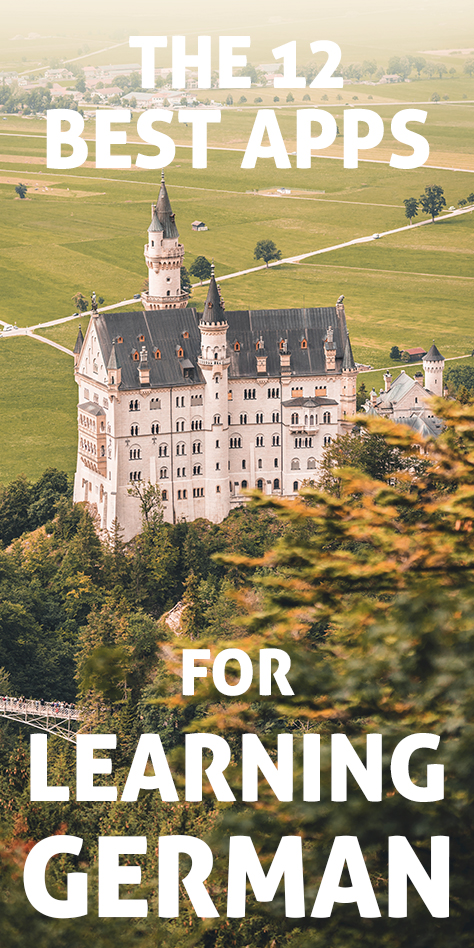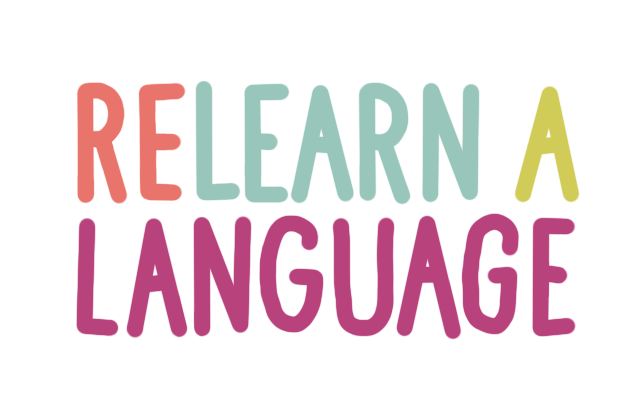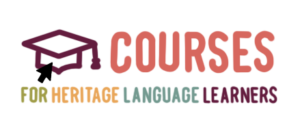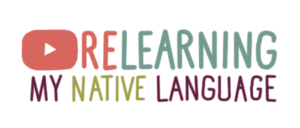Learn German with an App (12 German Language Apps Reviewed)
by Marissa Blaszko · February 16, 2020
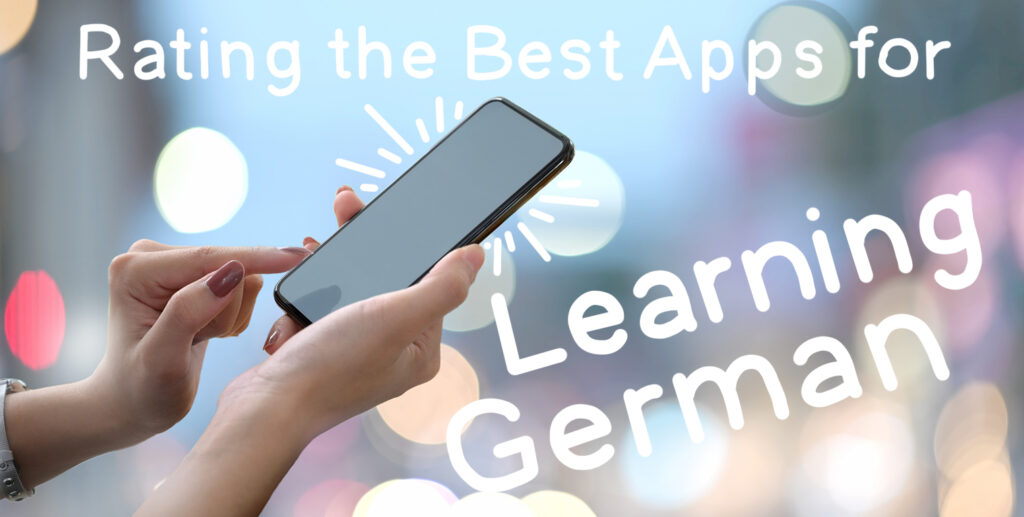
In 2021, anyone who wants to learn German wants to learn German with an app.
But not all language learning apps are built equally–and very few sites have side-by-side, unbiased (and unpaid) comparisons of the apps on the market.
I have spent the past year trying to learn German with one app after another, so here are my tops picks for other language learners. (And at the end of the article, I’ll talk more about how my German learning is going, and what else I’ve used besides apps.)
FYI, I’m affiliated with a few of the apps on this list. However, that does not influence my reviews, the order they’re listed in, or anything else about this article. It just means I may get a small commission if you make certain purchases.
Learn German App info: at a glance
Focus is about the two major areas of language learning (vocabulary, grammar) and four major skills (listening, reading, speaking, writing).
Levels is broken up by the Common European Reference Framework: A1-A2 (beginner) B1-B2 (intermediate) C1-C2 (advanced).
Amount of Content is the estimated hours that it would take for you to finish the app.
Price is in USD, plus how you pay (one-time payment, subscription, etc).
2 Sentence Review is a fast summary and critique of the app, based on my actual experience as a language learner (and without any paid sponsors).
Language Learning Notes will help you get the most out of this app so you actually learn German.
A Quick Note about How To Learn German with an App
This list is meant to help you pick the best app for learning German, but as someone who speaks a handful of languages, you cannot learn German with only an app.
Sure, an app is a fun tool for learning a language. But to truly immerse yourself in language learning, I suggest this article about how to learn German beyond an app.
Learn German with an App
Anki
Focus: DIY Flashcard App
Levels: n/a
Amount of Content: n/a
Price: free on Droid and desktop; several versions on iPhone from $20-60
2 Sentence App Review: Techy as it might be, Anki is probably the most-beloved flashcard app by med students, programmers, and polyglots. Easily insert vocab on one side with translations, images, and sound on the other.
Language Learning Notes: Anki is amazing when used in conjunction with other apps or sources. Some apps (like Seedling or Memrise) have their own built-in spaced repetition, but for apps like DW Learn German or Polygloss, Anki makes a great companion.
DW Learn German App
Focus: Listening, grammar, vocabulary
Levels: A1.0 – B1.2
Amount of Content: 90min video, 100hrs of activities
Price: free
2 Sentence App Review: DW Learn German is a state-funded exception to the language ruling rule of “you get what you pay for”. Using videos, quizzes, plenty of listening exercises, and word lists, it’s a great guide from getting you to zero-to-early beginner.
Language Learning Notes: This German app is a great guide, but to properly understand (and learn) the content it gives you you’ll want to upload all of the vocabulary and rules you learn into a flashcard deck like Anki (or use it as a supplementary language learning system to a more well-rounded program).
Seedling
Focus: Listening, vocabulary
Levels: A1-C2
Amount of Content: 1,000+hrs (when combined with the Easy German YouTube channel)
Price: $7.55/mo
2 Sentence App Review: From the beloved Easy German team, Seedling combines amazing videos, listening, and heaps of vocab to create an immersive (and intuitive) flashcard experience. Use it with any of the Easy German YouTube videos for an at-home visit to the streets of Berlin!
Language Learning Notes: Seedling is probably the best app on the market for vocabulary, especially for those who don’t like flashcards. If you use it with a formal course (as well as the YouTube Easy German channel and Patreon worksheets) you’ll be miles ahead of everyone else.
Focus: Vocabulary
Levels: A1-B2
Amount of Content: 63 units, 1-2hrs each
Price: $4.99/mo per language, $9.99/mo for all languages, or $99 for a lifetime language access
Drops
Focus: Vocabulary
Levels: A1-B2
Amount of Content: “2000+ words”
Price: Monthly $9.99, yearly $69.99 (for all languages)
2 Sentence App Review: Drag-and-drop words and images through a colorful screen while you slowly associate German words with what they mean. While it doesn’t have the same learning efficiency as other German apps on this list, its pretty interface makes it a good way to slowly start learning passive vocab.
Language Learning Notes: Drops is, like its parent company Kahoot, a gamified language platform. I did the 90 Days with Drops challenge (basically keeping a 90-day streak) and in my daily 15-30min I could identify around 400 new words but couldn’t use very many of them in conversation.
Michel Thomas
Focus: Grammar, speaking
Levels: A1.0-B2
Amount of Content: 18hrs
Price: $150
2 Sentence Review: Downloadable through the app, iTunes, or Audible, the Michel Thomas audio courses will give you the “backbone” of the German language in a handful of weeks.
Language Learning Notes: I know this is the priciest learn German app on this list (and not really an app at all), but for tricky German grammar this is the holy grail. Pair Michel Thomas with a great vocab strategy and you’ll be soaring.
Language Transfer
Focus: Grammar, speaking
Levels: A1-A2
Amount of Content: 10-15hrs
Price: free
2 Sentence Review: Not sure if you’ll like audio courses to learn with? Before you take the plunge into Michel Thomas (above) or Pimsleur (below), try Language Transfer–their open-source cousin.
Language Learning Notes: While the quality of Michel Thomas is better (and the style of Pimsleur, below, totally different) give Language Transfer a try. I find doing 2 lessons a day a really reasonable pace and, although both Michel Thomas and Language Transfer tell you to not take any notes, I like to review every few days by going back and putting some notes directly into my Anki app.
Pimsleur
Focus: Speaking
Levels: A1.0-B1.0
Amount of Content: 30hrs
Price: $18 x 5 levels
2 Sentence Review: “Repeat after me.” This old-fashioned audio course is still much-loved by many language learners to help you learn German in the car or on the go.
Language Learning Notes: I personally don’t love Pimsleur because I find it way too slow (especially in comparison with Michel Thomas or Language Transfer). But if those courses are too heavy for you, the German Pimsleur course was a nice way for me to relax when I was too tired to do any heavy-lifting language learning.
Mango
Focus: Grammar, speaking, listening
Levels: A1-B1
Amount of Content: 300-400hrs
Price: $7.99/mo for 1 language, $9.99/mo for all languages, $90/year for all languages, free through many libraries
2 Sentence Review: Mango combines the repeat-after-me strategies of Pimsleur with do-it-yourself flashcards. Focusing on high-frequency vocabulary in common situations, it’s the learn German app I recommend most to travelers or tourists who want to learn some survival German.
Language Learning Notes: Mango goes slowly on the language but hard on the repetition. If you want to travel, pair this one with the real-life practice of Easy German YouTube or the DW Learn Deutch in-app movie for some listening practice you won’t want to neglect.
Memrise
Focus: Grammar, vocabulary, listening
Levels: A1-B1
Amount of Content: 300-400hrs
Price: $8.99/mo, $59.99/year
2 Sentence Review: Memrise is another repeat-after-me x flashcard-app mashup that combines videos and spaced repetition to pile some German into your head. Their explanations and extra materials aren’t quite as good as Seedling (and flashcards not as simple as uTalk) but they’re a popular contender.
Language Learning Notes: When you compare apps like Seedling or Memrise to DuoLingo, it’s clear to see what a difference real native content can make in your German learning journey.
Polygloss
Focus: Writing
Levels: A1-B1
Amount of Content: Endless (player vs player game)
Price: Free
2 Sentence Review: Write and receive riddles from native speakers of your target languages as you improve your written communications skills! Polygloss is the only app on the market that features real interactions without the pressures of exchanges or pen pals.
Language Learning Notes: If you plan on actually interacting with German, being able to write texts or emails is a must! The Polygloss app is the easiest and lowest-pressure way to do this, with options to receive corrections or just experiment with the language.
The Best Way to Learn German with an App
As I said in the introduction, I wanted to give you my own personal formula for learning German.
The context is that, because I already speak or study half a dozen other languages, German is my fun escape. To keep the pressure off myself, I only study up to 30min a day and have set a strict budget of $0. (It’s a challenge and honestly I wish I could use some of the nicer apps on this list, but I know that once I start putting money into it I’ll start expecting real results–the opposite of this language learning experiment!)
My German Plan
- Daily warm-up with an Easy German video + Anki card review (10-20min total, depending on the day)
- Twice a month sessions with DW Learn German App (which includes loading the new things I learn into Anki)
- Once a month Michel Thomas or Language Transfer session (I set aside a week to go through 2 lessons a day during that time, alternating weeks with the DW app)
- Whenever I learn a new concept, I write a note or postcard to a native speaker friend that uses that grammar (letting them know I don’t want corrections just yet, but just some encouragement!)
- A once a week voice note to a native speaker friend (again, just for encouragement since I’m still a beginner!)
- Plenty of music
Once I hit intermediate (at this pace, probably a year from now) I’m also excited to be starting some graded readers and language exchanges! Language learning is a marathon and not a sprint, so I’m not stressing in how long it’ll take me to get there but looking forward to arriving when the time is right.
